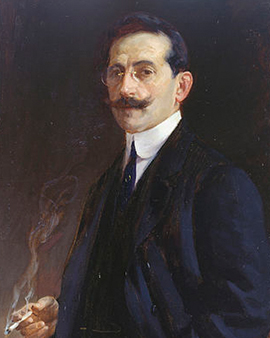Enrique Simonet was a Spanish painter who gained international recognition with religious and foreign themes in a mixture of impressionism and realism.
Enrique Simonet abandoned a religious vocation early on in favor of painting. His studies, begun at the Real Academia de Bellas Artes de San Carlos in his native Valencia, led him to the workshop of Bernardo Ferrándiz in Malaga in the circle of the relatively newly founded Escuela malagueña de pintura. In 1887 he received a scholarship to Rome, where in 1890 he created one of his most famous works, The Anatomy of the Heart, or The Anatomy for short. He made several trips: through Italy, several times to Paris, and in 1890 across the Mediterranean and even to the Holy Land. The years 1893 and 1894 took him to Morocco as a correspondent for the journal La Ilustración Española Americana.
Enrique Simonet's horizon of experience is reflected in his work. Outstanding examples of religious themes are The Beheading of St. Paul from 1887, a Head of Jesus from 1891 and Flevit super illam, created under the impression of the trip to the Holy Land in 1892. In 1896 Dance of the Veils testifies to the influence that the stays in Morocco made on him. In 1897, he took up a Spanish theme with El Quite, namely the moment after the bullfight in which two matadors try to save their fallen colleague. Not only in this work, but to a particular extent already in the Beheading of St. Paul and the Anatomy of the Heart, a predilection for the drastic is evident, which, despite the impressionistic expression, conceals nothing. Here may be seen the influence of the Malaga school, which pursued a realism adapted to the rich bourgeoisie, without a social component. In addition, he also had a preference for landscape depictions.
Simonet's work struck a chord with the times. Flevit super illam won several awards: in Madrid in 1892, in Chicago in 1893, in Barcelona in 1896, and in Paris in 1900. International recognition earned him the chair of studies of the forms of nature and art at the Reial Acadèmia Catalana de Belles Arts de Sant Jordi in Barcelona in 1901. In 1921 and 1922 he was director of the Residence for Landscape Painters in the former monastery of El Paular, and he held a chair at the School of Painting, Sculpture and Printing in Madrid, where he died on April 20, 1927. The fame during his lifetime was quickly forgotten. Today Simonet is remembered mainly for his more drastic depictions of the Beheading of St. Paul and the Anatomy of the Heart.
×





.jpg)
.jpg)
.jpg)
.jpg)
.jpg)
.jpg)
.jpg)
.jpg)
.jpg)
.jpg)
.jpg)
.jpg)
.jpg)
.jpg)
.jpg)
.jpg)
.jpg)
.jpg)
.jpg)
.jpg)
.jpg)
.jpg)
.jpg)
.jpg)
.jpg)
.jpg)
.jpg)
.jpg)
.jpg)
.jpg)
.jpg)
.jpg)
.jpg)
.jpg)
.jpg)
.jpg)
.jpg)
.jpg)
.jpg)
.jpg)
.jpg)
.jpg)
.jpg)
.jpg)
.jpg)
.jpg)
.jpg)
.jpg)
.jpg)
.jpg)
.jpg)
.jpg)
.jpg)
.jpg)
.jpg)
.jpg)
.jpg)
.jpg)
.jpg)
.jpg)
.jpg)
.jpg)
.jpg)
.jpg)
.jpg)
.jpg)
.jpg)
.jpg)
.jpg)
.jpg)
.jpg)
.jpg)
.jpg)
.jpg)






